SING A SONG OF AFRICA
Fela! is a scorcher. On these chilly nights in December and January, everyone (with a vested interest in the continuing power of musical theater) should retreat to the Ahmanson Theatre, where the heat is on. Warning: Do not try to put the fire out. Let the blaze burn bright. There are some conflagrations that are absolutely essential to our collective well-being.
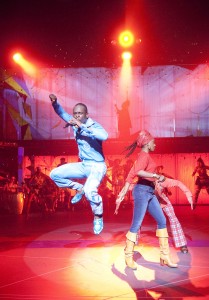 There is not a single moment in this beautifully conceived work of art that has escaped the unfailing eye of Bill T. Jones, who created, directed, and gorgeously choreographed Fela! Wherever the eye goes, something thrillingly alive is going on. The simple idea that Jones has found to tell the story of Fela Anikulapo-Kuti is to imagine a concert at the Africa Shrine in Lagos, Nigeria in the 1970s, just months after the tragic murder of his activist mother Funmilayo, in which Fela recounts, through his music, the powerful saga of a man and a country at war against cultural imperialism – inspired partly by what he had learned from the Black Power movement in America where he had come to perform and where he worked until he was deported for being here illegally, and partly by the Nigerian government’s attempts to stop him from spreading his and his mother’s human rights agenda. If this sounds like forbidding and inflammatory material, make no mistake about it – it most definitely is – but the miracle of Fela! is that, in the theater, it is a rousing entertainment, so full of energy and passion and seductive wit that it transcends the darkness it embraces with the bounty of Fela’s musical imagination. The Afrobeat pulses through the evening with spellbinding results. One almost wants to get up there on the stage and dance with the fantastically talented dancers and performers and musicians who keep the rhythms flowing and reach out to us with infectious enthusiasm and a wickedly subversive indignation. Politics are on its mind, but pleasure is the guiding principle.
There is not a single moment in this beautifully conceived work of art that has escaped the unfailing eye of Bill T. Jones, who created, directed, and gorgeously choreographed Fela! Wherever the eye goes, something thrillingly alive is going on. The simple idea that Jones has found to tell the story of Fela Anikulapo-Kuti is to imagine a concert at the Africa Shrine in Lagos, Nigeria in the 1970s, just months after the tragic murder of his activist mother Funmilayo, in which Fela recounts, through his music, the powerful saga of a man and a country at war against cultural imperialism – inspired partly by what he had learned from the Black Power movement in America where he had come to perform and where he worked until he was deported for being here illegally, and partly by the Nigerian government’s attempts to stop him from spreading his and his mother’s human rights agenda. If this sounds like forbidding and inflammatory material, make no mistake about it – it most definitely is – but the miracle of Fela! is that, in the theater, it is a rousing entertainment, so full of energy and passion and seductive wit that it transcends the darkness it embraces with the bounty of Fela’s musical imagination. The Afrobeat pulses through the evening with spellbinding results. One almost wants to get up there on the stage and dance with the fantastically talented dancers and performers and musicians who keep the rhythms flowing and reach out to us with infectious enthusiasm and a wickedly subversive indignation. Politics are on its mind, but pleasure is the guiding principle.
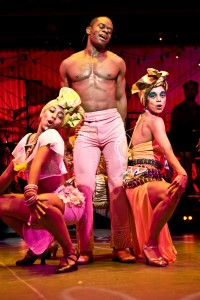 Most of the pleasure comes from Fela Kuti’s songs; the book that Jones and Jim Lewis collaborated on spins naturally out of Fela’s lyrics, rather than trying to fit his songs into some master scheme of their own, and the music seems to liberate them in much the way that, historically, Fela’s throbbing beat helped to liberate his own people.
Most of the pleasure comes from Fela Kuti’s songs; the book that Jones and Jim Lewis collaborated on spins naturally out of Fela’s lyrics, rather than trying to fit his songs into some master scheme of their own, and the music seems to liberate them in much the way that, historically, Fela’s throbbing beat helped to liberate his own people.
But, in the theater, it is the vivid presence of Sahr Ngaujah that brings Fela magically to life; this is one of those rare performances in which actor and character are somehow woven into a single entity, one so much becoming the other that, ultimately, it is impossible to separate one from the other. Sahr Ngaujah is Fela Kuti. He struts, he cajoles, he shows you exactly why Fela was not only a great showman but a magnetic political force. (Adesola Osakalumi alternates in the part, and, since this is a show you will probably want to see more than once, it might be fun to compare the two interpretations.)
The entire cast that swirls around Ngaujah deserves individual attention, but it is Melanie Marshall, in the pivotal part of the dead mother, Funmilayo, who truly dominates the stage whenever her ghost haunts the Shrine auditorium, and her voice is capable of making sounds this reviewer hasn’t heard since the days of the great Mahalia Jackson; and, in “Rain,” she doesn’t merely stop the show but brings it to a startling new high. If we are not moved to tears, it is only because we are so stunned by the sheer mesmerizing sound of her glorious vocal instrument.
Paulette Ivory brings a sinuous sexuality to Sandra, the woman who inspires Fela. Ismael Kouyaté does a mean James Brown. And there is not enough of Gelan Lambert’s marvelous tap dancing, which reminds one of some of the majesty of Savion Glover.
And attention must be paid to the rich contributions of the designers, especially the resplendently fantastic costumes of Marina Draghici (who is also responsible for the scenic design) and the haunting projections of Peter Negrini, whose work is in perfect harmony with the elaborate and intricate lighting by Robert Wierzel. Together, they prove that, in the creation of a truly committed work of artistic expression, everyone must work at the height of his or her talents. Nobody’s work stands out; instead, they complement each other, fitting perfectly into the overall design, which, in this case, is magnificent.
You may not learn everything there is to know about the complex figure that, in truth, Fela Kuti was; still, as an introduction to the man, his life, and his music, Fela! achieves true greatness. But, while Fela is the one you will remember, it is Bill T. Jones who is the genius behind Fela!; Jones is the man responsible for finding a way to infuse new life into the often moribund musical theater. This is as stunning and as stirring and as brilliantly imagined a piece of commercial theater to come our way in a long time. It has style as well as substance. And it’s got a heart as big as Fela’s. And it’s hot Hot HOT!
photos by Tristam Kenton, Raymond Hagans, and Monique Carboni
Fela!
national tour kick-off
Ahmanson Theatre in Los Angeles
end on January 22, 2012
for tickets, visit CTG
tour continues through June 17, 2012
for schedule, dates, and tickets, visit Fela

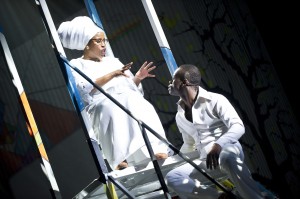
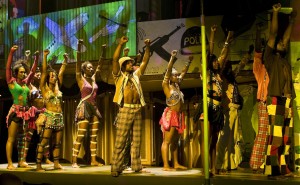
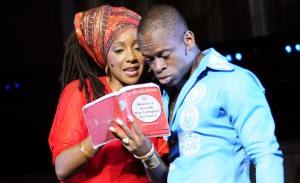
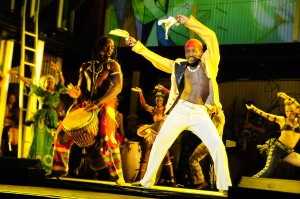
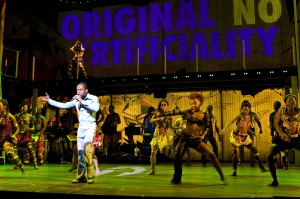

{ 2 comments… read them below or add one }
As Fela’s former manager reading your review of the show of which I’m so inordinately proud was a true delight. You really got it!!!
Everybody say “Yeah Yeah”!
That is truly a heartfelt emotional revue. Loved the pictures too.